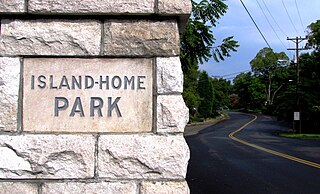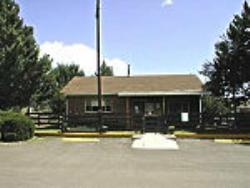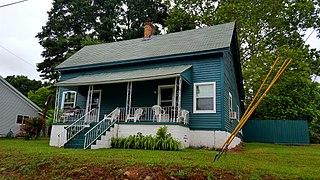
The Richard Nixon Birthplace is the birthplace and early childhood home of Richard Nixon, the 37th president of the United States. It is located on the grounds of the Richard Nixon Presidential Library and Museum in Yorba Linda, California, and serves as a historic house museum.

Druid Hills Historic District is a historic district in Druid Hills and Atlanta in DeKalb County, Georgia, United States, that is listed on the National Register of Historic Places (NRHP).

The Brookfield Center Historic District in Brookfield, Connecticut is a historic district that was listed on the National Register of Historic Places in 1991. It is located in the vicinity of the junction of Route 133 and Route 25. The district represents the original settlement of the town of Brookfield and contains 67 residential, religious, and municipal buildings over a 43-acre (17 ha) area representing a wide range of architectural styles from the 18th to 20th centuries including Bungalow/Craftsman, Greek Revival, and Queen Anne style architecture. The district includes the old town hall, the Congregational Church of Brookfield, Saint Joseph Church & Elementary School, Center Elementary School (Public), the former general store, St. Paul's Episcopal Church, and the surrounding residential neighborhood. The district is architecturally significant as an accurate representation of the historical development of the original settlement of the Town of Brookfield as the buildings are well-preserved from the time they were built with minimal alterations and intrusions, including their spatial relationships to one another.

The Drake Park Neighborhood Historic District is located adjacent to Drake Park near the historic downtown area in Bend, Oregon, United States. Because of the unique and varied architecture in the Drake Park neighborhood and its close association with the early development of the city of Bend, the area was listed on the National Register of Historic Places in 2005.

Island Home Park is a neighborhood in Knoxville, Tennessee, United States, located in the southeastern part of the city along the Tennessee River. Developed as a streetcar suburb in the early 1900s, the neighborhood retains most of its original houses and streetscapes, and is home to the city's largest concentration of Bungalow-style houses. In 1994, several dozen houses in Island Home Park were added to the National Register of Historic Places as the Island Home Park Historic District.
Odd Fellows' Home or Odd Fellows Home may refer to:
The Carmen IOOF Home, also known as or associated with The Carmen Home of Pentecostal Holiness Church, is an Odd Fellows building in Carmen, Oklahoma that was built in 1906. It has served historically as institutional housing. It was listed in the National Register of Historic Places in 1984.
The Adams Street Historic District in Franklin, Tennessee consists of properties at 1112-1400 Adams, 1251-1327 Adams St., and 304-308 Stewart St. It is a 14-acre (5.7 ha) historic district was listed on the National Register of Historic Places in 2000 and is one of seven local historic districts in the city of Franklin.

The Beaver Creek Ranger Station near Rimrock, Arizona was built in 1935 by the Civilian Conservation Corps. It was designed by architects of the U.S. Forest Service. It was listed on the National Register of Historic Places on June 10, 1993, for its architecture, which is of Bungalow/Craftsman style. It served historically as institutional housing and as government office space. The NRHP listing was for three contributing buildings and two other contributing structures on a 47-acre (19 ha) area.

The Camp Clover Ranger Station, about two miles west of Williams, Arizona, was built in 1934 by the Civilian Conservation Corps. It was listed on the U.S. National Register of Historic Places in 1993 for its architecture. It was designed by the USDA Forest Service in Bungalow/Craftsman style. It served historically as institutional housing and government office space.
The Pinedale Ranger Station is in the Apache-Sitgreaves National Forests, and located near Pinedale in Navajo County, Arizona.

The Pleasant Valley Ranger Station, known also as Pleasant Valley Administrative Site and Young Ranger Station, in Tonto National Forest near Young, Arizona was built in 1919. It was listed on the National Register of Historic Places in 1993 for its architecture.

The Portal Ranger Station, also known as Portal Work Station, is located in Cave Creek Canyon, in the eastern Chiricahua Mountains, in Coronado National Forest near Portal, southeastern Arizona.
Walnut Creek Ranger Station, also known as Walnut Creek Work Center, in Prescott National Forest near Prescott, Arizona was built in 1931 by the Civilian Conservation Corps. It was listed on the National Register of Historic Places in 1993 for its architecture, which is Bungalow/Craftsman style. It was designed by architects of the United States Forest Service. It served historically as institutional housing and as government office space. The NRHP listing included two contributing buildings on a 5-acre (2.0 ha) area.
Water Canyon Administrative Site, in Apache-Sitgreaves National Forest near Springerville, Arizona, United States, was built in 1933. It was listed on the National Register of Historic Places in 1993 for its architecture, which is Bungalow/Craftsman style. It was designed by architects of the United States Forest Service. It served historically as institutional housing and as government office space. The listing included four contributing buildings on 6 acres (2.4 ha).

The North Charlotte Historic District is a 155.5-acre (62.9 ha) national historic district located in Charlotte, Mecklenburg County, North Carolina. The listing included 282 contributing buildings and four contributing structures. It includes work designed by architect Stuart Warren Cramer; it includes Bungalow/craftsman, Late Victorian, vernacular Victorian, reflecting turn-of-the-century mill-village architecture. Located in the district is the separately listed Highland Park Mill No. 3. Other notable buildings include the Mecklenburg Mill, Johnston Mill (1913), Grinnell Manufacturing Company, Hand Pharmacy Building (1904), Lowder Building (1927), the former Highland Inn, Charlotte Fire Department Engine Company No. 9 (1937), and North Charlotte Primary School.

The Witham Cotton Mills Village Historic District is a 18 acres (7.3 ha) historic district in Hartwell, Georgia. The district included 47 contributing buildings along Liberty Circle, Jackson, and Webb Streets in Hartwell, including Bungalow/craftsman, Late Victorian, and vernacular Victorian architecture.
Caplewood Drive Historic District, in Tuscaloosa, Alabama, is a residential historic district which was listed on the National Register of Historic Places in 1985. It included 37 contributing buildings out of a total of about 45 buildings, on 11 acres (4.5 ha).
The C.B. Power Bungalow, also known as The Bungalow Bed and Breakfast, in Lewis and Clark County, Montana in the vicinity of Wolf Creek, Montana was built in 1911. It was listed on the National Register of Historic Places in 1995 for its architecture. It was opened as a bed and breakfast in 1993.













